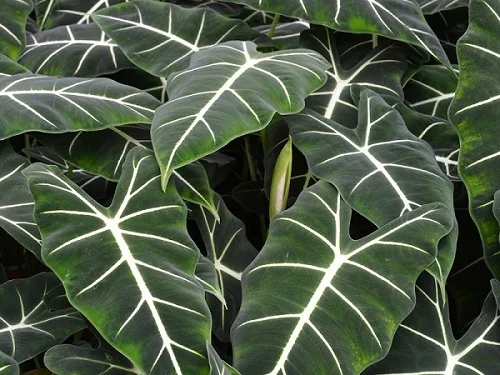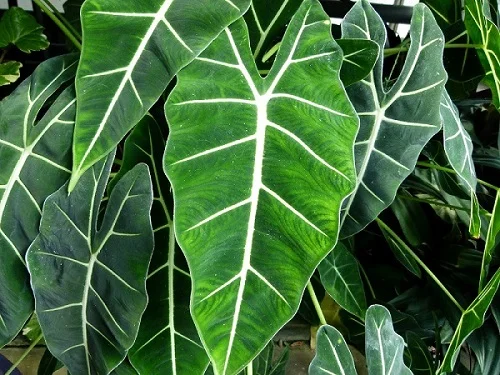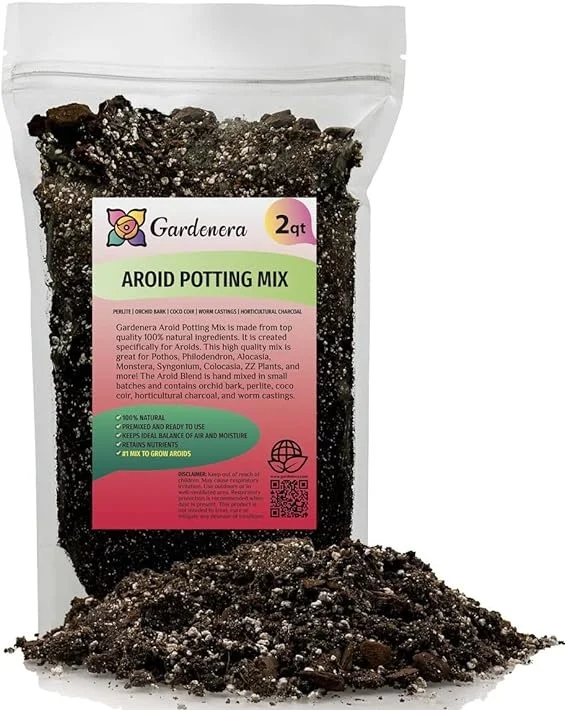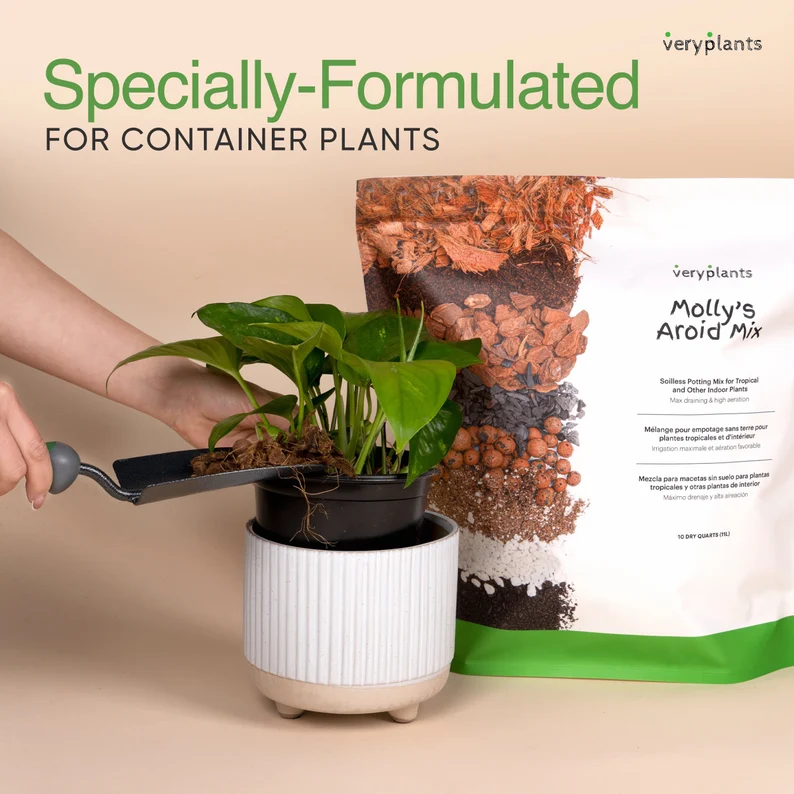How to Grow and Care for Alocasia micholitziana (Green Velvet Alocasia) Indoors
Some links in this post may be affiliate links
Alocasia micholitziana (Green Velvet Alocasia) requires bright indirect light, warm and humid conditions and moderately moist, rich, well-drained soils coupled with monthly feeding in the growing season.
Alocasia micholitziana is among the popular Alocasia varieties and bears arrow-shaped, deep matte-green leaves with a velvety texture on the upper surface and white veining, and pale-green undersides.
The leaves are borne on mottled, brown-red or purple leaf stalks and grow to about 1 foot long and 6-8 inches wide. The stem is short and the leaves appear to emerge from the ground.
Alocasia micholitziana was described by Henry Fredrick Conrad Sander in 1912. He named it after the German Plant collector, Wilhelm Micholitz.

Botanical name: Alocasia micholitziana
Family: Araceae
Common name: Green Velvet Alocasia
Origin
Alocasia micholitziana is endemic to the Island of Luzon in the Philippines.
Size
Alocasia micholitziana is one of the fast-growing plants which grows to a height of about 2-3 feet and a width of about 2 feet. The leaves are about 1.3 feet long and about 6-8 inches wide placing it among the best plants for the living room for a bold statament.
Flower
Green Velvet Alocasia flowers are a greenish spathe and a cream-colored spadix which only last a few days. To conserve the plants energy and direct it to foliage growth, cut the flowers as soon as they appear, though, it is unlikely to flower when grown indoors.
Is Alocasia micholitziana toxic?
Yes. Alocasia micholitziana is toxic to both humans and pets as indicated by ASPCA. It contains crystals of calcium oxalate which if ingested can numb and swell the tongue and pharynx leading to difficulty in breathing and sharp pain in the throat. Keep the plant away from the reach of children, cats, dogs and other pets to avoid any mishaps.
Where to Buy
If you are looking to add this amazing Green Velvet Alocasia to your collection, they are available online from Amazon (Link to Amazon).
How to care for Alocasia micholitziana indoors
To care for Alocasia micholitziana indoors, provide bright indirect light, average warmth of 18-250C, humidity of 60-70% and moderately moist, fertile, well-drained soils coupled with monthly feeding in spring and summer.
Green Velvet Alocasia care also requires regular pruning to keep it neat and tidy as well as discourage pest and disease infestations. Repotting is only necessary when it becomes pot-bound. Keep reading for more on these growing conditions and how to achieve them.

Watering
Water Green Velvet Alocasia liberally until water drips through the drainage hole in spring and summer. Allow the top 2-3 inches of soil to dry out between waterings. Maintain the soil moderately moist and avoid overwatering to prevent rotting, yellowing and leaf drop.
Decrease watering in fall and winter to keep the soil barely moist as growth is minimal at this time. Never allow the soil to dry out completely as underwatering will signal dormancy resulting in yellowing and leaf fall in readiness for dormancy.
Avoid chlorinated water as it can lead to browning of leaf edges; use rain water or filtered water. Ensure that the water is at room temperature to prevent cold shoch which can result in stunted growth and leaf loss.
The plant does not like soggy soil as it can lead to root-rot and death of the plant. Therefore, use a pot with a drainage hole and well-draining soil to prevent waterlogging. In addition, always discard excess water from the catch plate after watering.
Take care not to wet the foliage during water to discourage fungal leaf diseases; you may water from the bottom instead.
Light Requirements
Alocasia micholitziana grows best in bright indirect light (dappled light). Keep it away from direct sunlight to prevent scorching of the leaves; brown leaf marks.
Too little light will signal dormancy to the plant which may cause the leaves to start dying in readiness for dormancy. If the natural light is not adequate, use a full spectrum grow light to supplement it.
Rotate the pot regularly to ensure that the plant gets light on all sides for a balanced growth to prevent lop-sided growth.
Temperature and Humidity
Green Velvet Alocasia flourishes in an average warmth of 18-250C. Below 150C, the plant may drop all its leaves and go into dormancy stage.
Keep it away from sources of drafts which cause sudden changes in temperature resulting in reduced growth, yellowing and leaf drop.
Alocasia micholitziana prefers a humidity of 60-70%. To increase humidity set the pot on a wet pebble tray, use a humidifier or group the plants together.
You may also grow the plant in a well-lit bathroom, kitchen and other moist areas in the home. Make sure that there is good air circulation to minimize fungal diseases.
Feeding
Feed Green Velvet Alocasia with a balanced, liquid fertilizer every 3-4 weeks in spring and summer for a lush, healthy growth. Stop feeding in fall and winter as the plant undergoes dormancy during this period and growth is minimal at this time.
Flush out accumulated salts arising from fertilizers every 2-3 months by running a stream of water through the soil until the water comes out through the drainage holes. Let the stream of water run for a few minutes. Repeat the process several times.
Potting Soil
The best potting soil for Alocasia micholitziana should be rich in organic matter and well-draining to prevent waterlogging while providing the required nutrients. Aroids potting mixes are ideal for this plant.
Repotting
Green Velvet Alocasia prefers to be root-bound, therefore, frequent repotting is not needed and the plant can take long to recover from repotting shock.
Repotting every 2 years in spring to eraly summer is adequate. Repot into a pot 1 size larger only if the roots are growing through the drainage hole.
Select a pot with a drainage hole and free-draining soil to prevent waterlogging which can lead to root-rot and death of the plant. Take a look at these beautiful planters with drainage hole on Amazon.
Pruning & Grooming
Pruning Alocasia micholitziana is easy. Remove yellow and diseased leaves as they occur to maintain the plant neat and to reduce chances of diseases and pests infestation.
Cut the leaves at the base with a sterilized knife or pair of scissors to avoid disease transimission. Take care not to injure the new leaves that are forming.
Regularly clean the leaves by damp wiping them with a soft cloth to get rid of dust and also discourage pests infestations.
Alocasia micholitziana Propagation
Alocasia micholitziana (Green Velvet Alocasia) is propagated by plant division at the beginning of the growing season when in active growth.
Propagating Green Velvet Alocasia by plant division
- Water the plant thoroughly at least one day before to make it easier to divide and also hasten establishment.
- Carefully, slip the plant out of its pot and gently divide the rhizome into sections by cutting through with a sharp sterilized knife. Ensure that each section has 1-2 stems.
- Fill small pots halfway with free-draining soil and moisten it lightly. Ensure that the pot has a drainage hole to prevent rotting.
- Position the section in the center of the pot and continue filling and firming the soil around the base. Keep the sections at the same depth that they were in the previous pot.
- Place the set up in a warm, well-lit place away from direct sunlight to avoid scorching.
- Wet the soil throughly and maintain it moist until new growth emerges and the plant is well established.
- Once well established, transplant the plant into a pot one size larger and begin routine care.

Alocasia micholitziana Problems & Remedies
Green Velvet Alocasia problems are yellow leaves, plant dying, drooping leaves, brown leaf tips and edges, pests and diseases. Keep reading for more on these problems and how to fix them.
Yellow leaves
Some of the causes of yellow leaves on Green Velvet Alocasia are dry air, overwatering, soggy soil, nutrients deficiency, and aging.
How to fix it
Remove such leaves by snipping them off at the base with a clean sharp knife or a pair of scissors.
Dry air: Set the pot on a wet pebble tray or use a humidifier or grow the plant in a well-lit bathroom.
Overwatering: Water only when the top 2-3 inches of soil feel dry. Do not water on a schedule.
Soggy soil: Use well-draining soil and a pot that has a drainage hole.
Nutrients deficiency: Apply a balanced, water-soluble fertilizer every 3-4 weeks in spring and summer.
Aging: It is natural for the old leaves to turn yellow and drop as the plant matures.
Plant dying
Alocasia Green Velvet is dying due to too little light, underwatering, and cold drafts. These three signal dormancy to the plant causing the leaves to begin to die.
Naturally, this happens in winter. However, even if the foliage may die, the underground rhizome is still alive and can regrow when given favorable conditions.
How to fix it
If you do not want your plant to die in winter do the following:
Too little light: Position the plant near a bright window where it will receive bright indirect light or instal a grow light if the natural light is enough.
Cold drafts: Keep it away from cold drafts like drafty windows, windy doors, AC units among others and use a heating mat to maintain a warmth of 18-250C.
Underwatering: Water when the top 2-3 inches of soil feel dry but do not allow the soil to dry out completely.
Drooping leaves
Drooping leaves on Alocasia micholitziana are caused by underwatering, temperature stress, dry air, and pests infestation.
How to fix it
Underwatering: Water when the top 2-3 inches of soil dry out but do not allow the soil to dry out completely.
Temperature stress: Keep the plant away from drafts emanating from AC units, heat sources and others to maintain temperatures of 18-250C.
Dry air: To elevate humidity, set the pot on a wet pebble tray, use a humidifier or group the plants together.
Pests infestation: Keep the plant well pruned and raise humidity to discourage the pests.
Brown leaf edges
Brown leaf edges on Green Velvet Alocasia are caused by low humidity, underwatering and salts buildup.
How to fix it
Low humidity: To raise humidity, set the pot on a wet pebble tray or use a cool mist humidifier.
Underwatering: Water when the top 2-3 inches of soil feel dry but not leave the soilball to dry out completely.
Salts buidup: Flush out the accumulated salts from the soil every 1-2 months by running a stream of water through the soil until it drips through the drainage holes.
Pests
Common pests on Alocasia micholitziana are mealybugs, aphids, spider mites and scale insects.
How to fix it
- Check underneath the leaves regularly for these pests and take timely control measures.
- Seperate the affected plant to prevent spread to other plants.
- Treat the affected plant with neem oil or insecticidal soap as per the manufacturers' recommendations.
- Regularly damp-wipe the leaves with a soft cloth to discourage the pests.
- Maintain the plant well pruned to reduce the hiding and breeding places for these pests.
Diseases
Alocasia micholitziana is prone to leaf spot disease which is enhanced by soggy soil and overwet conditions. It is characterized by dark-brown or black leaf spots.
How to fix it
- Remove and burn the affected parts to reduce spread to the rest of the plants.
- Spray the affected plant with a systemic fungicide and ensure to follow the manufacturer's instructions.
- Keep the plant on the dry side, do not mist it and ensure good air flow.
- Use a pot with a drainage hole and a well-draining soil.
You liked it? Share on social media.
Related Content
Amazon Associates Disclosure
Homeplantsguide.com is a participant in the Amazon Services LLC Associates Program, an affiliate advertising program designed to provide a means for sites to earn advertising fees by advertising and linking to amazon.com.





